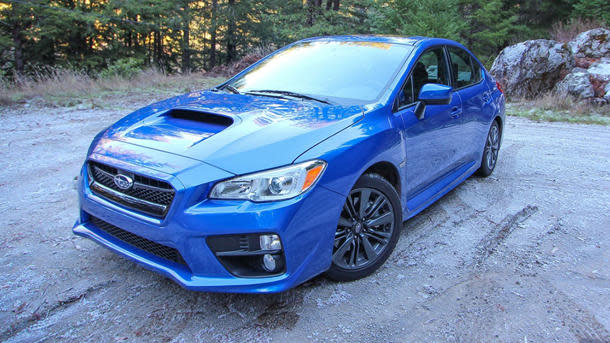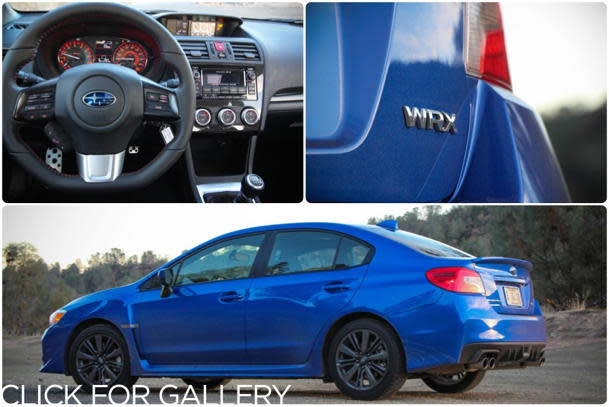 Motoramic
Motoramic2015 Subaru WRX, the sharper tool: Motoramic Drives
There are cool cars, and then there are cult cars. Cool cars — like, say, the Volkswagen GTI — are admired by the masses. Cult cars are loved — obsessed over, really — by a fanatical few. And as far as cult cars go, few can top the Subaru Impreza WRX.
Crafted from the econocar bones of the humble Impreza and pumped up with a raucous turbocharged engine, rally-bred all-wheel drive system and zoomy body modifications, Subaru’s scrappy little WRX has spent over two decades picking fights with many sports cars costing twice as much. And it often wins, especially when the weather gets nasty.
Early on, Subaru sold the WRX (and its even gnarlier STI variant) only overseas, where the popularity of rally racing gives the WRX a built-in market. But a groundswell of demand for the WRX eventually prompted Subaru to import the WRX to these shores in 2001. Now, nearly 80 percent of all WRXs are sold in the United States.
We bring this up primarily to explain why Subaru dropped the WRX hatchback for its all-new 2015 redesign. Previously, the WRX sales were about half sedan, half five-door hatchback. But according to Subaru, limited engineering resources forced it to choose one style, and since Americans generally prefer four doors to five, the hatch gets the ax. This will certainly disappoint many WRX fans whose contrarian spirits make hot-shoe hatchbacks particularly delightful propositions; to them, we say wait another year or so until the next-gen STI appears, which we suspect will return to hatchback form.
Or they can swallow hard and get on board with the new WRX sedan, which is so much fun to drive that they may not care what the cargo hold looks like.
Indeed, Subaru’s “limited resources” have turned out a WRX so thoroughly transformed that it seems closer to the outgoing STI screamer than the previous WRX. The new structure is 40 percent stiffer, thanks to liberal use of high-strength steel and aluminum, with additional bracing beyond the already stiff Impreza. Year-over-year weight gain has been kept to just 60 pounds.
The transformation continues with a new 2-liter, directly injected turbocharged boxer four-cylinder engine that pumps out 268 hp at 5,600 rpm and 258 lb-ft of torque from 2,000 through 5,200 rpm (up three ponies and 14 lb-ft from last year’s 2.5-liter engine).
Subaru estimates that 80 percent of WRX buyers will choose the new six-speed manual transmission, which features carbon synchronizers on first and second gears. A viscous center differential distributes torque 50/50 front/rear, unless grip is compromised at either axle, at which point more torque is sent to the axle with the best traction.
The other 20 percent of buyers are expected to opt for the new continuously variable transmission. While at first blush, a CVT in a WRX seems incongruous, if not horrifying, Subaru has done some interesting things to ensure that its “Sport Lineartronic” transmission does not behave with the gum-on-your-shoe character endemic to CVTs. First, it has three distinct modes: Intelligent, Sport, and Sport # (pronounced “sport sharp”), selectable via buttons on the steering wheel. In Intelligent mode, it behaves like a normal CVT until about 40 percent throttle application, at which point it “shifts” along six fixed ratios. Selecting Sport drops the threshold to 30 percent throttle and sharpens throttle response. The Sport # setting always operates in stepped mode, with eight fixed ratios, anticipatory downshifts and even sharper throttle calibration. In any setting, manual shifts may be summoned via standard steering wheel paddles or a separate manual gate at the shifter itself.
What’s more, the CVT comes with launch control — yes, a CVT with launch control is a thing — actuated simply by bringing the car to a stop, throttle-braking, then releasing the brake pedal. Finally, CVT models feature Subaru’s electric all-wheel drive system, which distributes torque with a planetary gear set and a clutch pack, with 45/55 front/rear torque distribution under normal driving. All WRX models supplement their all-wheel drive systems with brake-based torque vectoring, ensuring that the inside front wheel doesn’t get crazy in corners.
At our first drive opportunity in California, we found the new 2.0-liter to be a honey of a mill, with minimal turbo lag, buckets of passing power, and happily, a rowdy brrrrraaaaaaat from the quad exhaust tips. Not surprisingly, the manual is the more viscerally satisfying model to drive, with notchy cogs, short throws, and a progressive clutch.
But the CVT proved surprisingly good, easily the quickest-shifting, most hot-shoe-friendly CVT I’ve ever encountered. Particularly when left in Sport #, you may never encounter its CVT-ness. It will never be as quick-shifting as, say, VW’s lightning-fast DSG dual-clutch transmission, but it does operate as well as most conventional automatics in performance-car applications, and certainly could be a dealmaker for city-dwelling WRX customers, especially in dual-driver households.
How fast is it? Subaru claims a 0-60 mph time of 5.4 seconds for the manual, and 5.9 seconds, for the CVT. It should be noted that Subaru is notorious for conservative acceleration estimates, and from the driver’s seat, the CVT model feels way quicker than the numbers suggest.
Handling is simply glorious, thank in part to stiffer shocks and springs that lower the car by 10 mm and limit body roll to just 1.5 degrees. Combined with its quicker steering ratio (14.5:1 from 15 :1), the sportified suspension allows the WRX to quickly take a set and dive into corners as if it was an Olympic sport. Feedback through the wheel feels particularly impressive for an electric steering system. With such high cornering limits (Subaru estimates 0.92g of lateral grip), you may not have to slow down much for corners, but stupendous brakes are there in case you do, helping scrub off speed with good pedal feedback and, during our drive, no noticeable fade.
What surprised us most, however, is the WRX’s extraordinarily grip. As hard as we charged, we just couldn’t get the car to step out, or even get its tires to squeal, for that matter. Regardless of which all-wheel drive system the car has, it just sticks. The only fly in the ointment is a rough, noisy ride: the tougher WRX suspension handles potholes and expansion joints with all the compassion of an Alcatraz prison guard. But then, this is a level of handling that would make an STI proud, and we suspect it will please the WRX clan very much.
And it looks the part, too. Other than the front door skins and roof panel from the Impreza, every body panel is unique to the WRX. The “nose cone” front fascia moves the grille down and forward by several inches, and is flanked by headlamps with LED running lights and an appropriate amount of scowl. Flared fenders contain 17 x 8-inch multi-spoke wheels shod with 235/45 Dunlop SP Sport Maxx RT tires. The new rear end features an aggressive diffuser-style bumper, LED taillamps, a subtle lip spoiler and sexy quad pipes.
The new WRX is larger and more comfortable inside, too, with a particularly generous increase in shoulder room and nearly two more inches of rear legroom. Cabin intensity is enhanced by aggressively bolstered (and good-looking) sport seats, glistening carbon fiber and unique gauges with chunky, black chrome rings and a center info screen that tells you everything from trip info to current gear selection to throttle mapping.
The 2015 WRX should hit showrooms by early spring, with base models priced “within spitting distance” of the current car’s $26,790. This includes seven airbags, a rear camera, cloth upholstery, the six-speed manual, and more. As before, Premium and Limited models will also be offered, adding such niceties as heated seats, a sunroof, and on Limited versions, leather upholstery, all-LED headlights, optional navigation and 440-watt Harman/Kardon audio systems.
With a chassis worthy of the STI and attractive pricing, the WRX is shaping up to be a serious performance bargain. Indeed, we’re having a hard time imagining what the upcoming STI model could bring to improve upon the WRX other than added power and wilder bodywork. Oh yeah, and a hatchback body. Meanwhile, we’re quite happy with the 2015 WRX sedan. We’ll see if the rest of the cult agrees.

 Yahoo Autos
Yahoo Autos 


